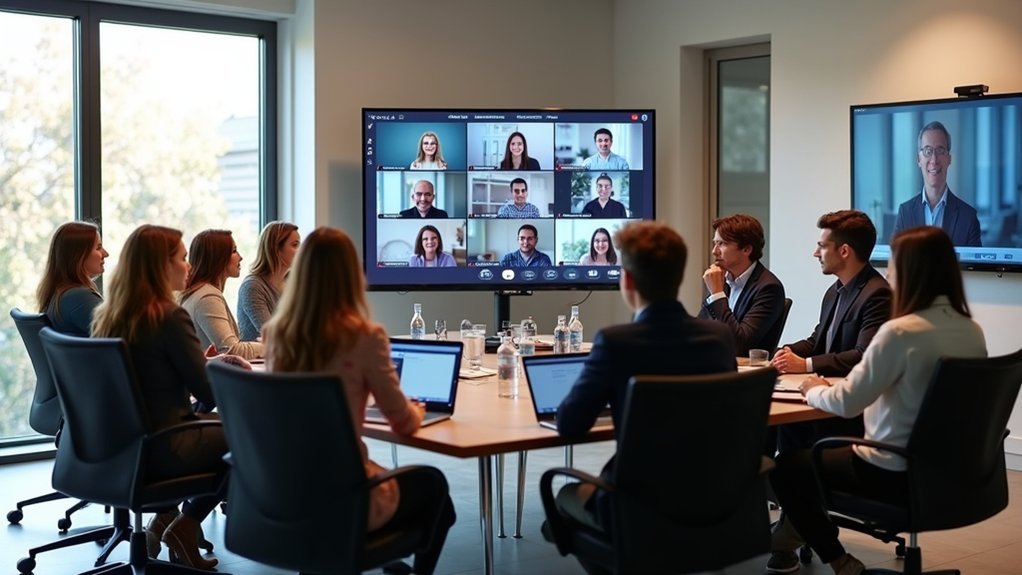You’re likely experiencing the silent productivity killer known as Zoom fatigue without even realizing it. Hybrid meetings have transformed workplace communication, but they’re also draining your cognitive resources faster than you might expect. Research indicates that prolonged virtual interactions tax your brain’s processing capabilities, leading to mental exhaustion and decreased engagement. The consequences aren’t just abstract—they’re measurable impacts on team performance and individual well-being. Want to understand how to reclaim your meeting momentum and combat this pervasive modern workplace challenge?
Key Takeaways
- Implement the 20-20-20 rule to reduce eye strain by looking away from screens every 20 minutes for 20 seconds.
- Limit virtual meeting durations to 30-50 minutes and intentionally schedule breaks between digital interactions to minimize cognitive overload.
- Hide self-view during video conferences to reduce mirror anxiety and mental exhaustion associated with constant visual self-monitoring.
- Leverage audio-only modes and asynchronous communication tools when visual engagement is not critical to decrease screen time.
- Design meetings with clear agendas, defined roles, and interactive techniques like polls to enhance engagement and minimize participant fatigue.
Understanding Zoom Fatigue in Hybrid Environments

While hybrid work environments have become increasingly common, they’ve also introduced a complex phenomenon known as Zoom fatigue. This cognitive challenge stems from the increased mental load required during hybrid meetings, where participants must navigate simultaneous virtual and in-person interactions. Research indicates that Zoom fatigue disproportionately affects women, with 14% experiencing significant symptoms compared to 5.5% of men. The hybrid format creates unique stressors, including potential isolation for remote participants and heightened engagement pressures. Extended screen time contributes to eye strain and muscular tension, compounding the psychological demands of virtual work. Understanding these dynamics is essential for developing effective strategies to mitigate the physiological and psychological impacts of prolonged video conferencing in modern workplace environments.
Physical and Cognitive Impact of Virtual Meetings

Because virtual meetings demand unprecedented cognitive resources, professionals increasingly experience complex mental and physical strain during extended video conferencing sessions. You’ll encounter heightened cognitive load that requires simultaneous processing of visual and auditory information, leading to significant virtual meeting fatigue.
The persistent eye strain and body discomfort stem from prolonged screen engagement, reducing blinking frequency and restricting physical movement. Women, particularly, report higher levels of exhaustion, experiencing 14% more Zoom-related stress compared to men. Your remote and hybrid work environments amplify these challenges, necessitating strategic interventions to mitigate cognitive overload.
Research indicates that intense visual focus during video calls exponentially increases mental exhaustion, transforming what should be collaborative experiences into draining interactions that compromise professional effectiveness and well-being.
Gender Differences in Meeting Exhaustion

Why do women experience more profound virtual meeting exhaustion than their male counterparts? Research reveals stark gender differences in Zoom fatigue, with women reporting 14% higher levels of meeting exhaustion compared to men’s 5.5%. This disparity stems from multiple complex factors: longer meeting durations, shorter breaks, and heightened anxiety around self-image during video calls. Women face additional cognitive strain from societal pressures about appearance and performance in virtual meetings. The intersectionality of professional responsibilities and personal expectations creates a more intense experience of virtual meeting fatigue. These challenges are compounded by women’s typical multitasking roles, which increase mental load during video conferences. Understanding these gender differences is essential for designing more inclusive virtual work environments that recognize and mitigate the unique stressors women encounter in digital communication spaces.
Strategies for Reducing Screen Time
As digital professionals increasingly grapple with prolonged screen exposure, strategic interventions become essential in mitigating virtual meeting fatigue. Implementing targeted strategies can effectively reduce screen time and minimize eye strain during hybrid meetings and video calls.
Key approaches include:
- Apply the 20-20-20 rule to provide visual relief
- Leverage audio-only modes when visual engagement isn’t critical
- Schedule intentional breaks between virtual interactions
- Limit meeting durations to 30-50 minutes
- Utilize asynchronous communication channels for non-essential updates
These systematic interventions address the cognitive and visual challenges inherent in prolonged digital interactions. By consciously managing screen time, professionals can maintain productivity while preserving mental and ocular well-being. The goal isn’t complete elimination of digital communication but rather creating a more balanced, sustainable approach to hybrid meeting environments.
Optimizing Meeting Design and Duration
While digital collaboration continues to evolve, strategic meeting design has become critical in combating virtual interaction exhaustion. You’ll want to optimize meeting duration by limiting sessions to 20, 40, or 50 minutes, which helps maintain participant focus and reduces cognitive strain. Implement clear agendas with defined roles to streamline discussions and prevent unnecessary information overload. Schedule regular breaks during hybrid meetings to allow participants to refresh and mitigate physical fatigue from prolonged screen time. Leverage asynchronous communication for updates that don’t require live interaction, thereby reducing meeting frequency and providing more flexible engagement. Additionally, critically assess which meeting activities can be completed offline, minimizing virtual meeting time and preventing exhaustion from consecutive online interactions. This systematic approach guarantees more efficient and less draining digital collaboration.
Technology and Ergonomic Solutions
Technology and ergonomic solutions represent a strategic approach to mitigating Zoom fatigue beyond traditional meeting management techniques. By integrating advanced technological interventions and ergonomic design, you can considerably reduce the physiological and cognitive strain associated with video conferencing.
Key solutions include:
- Implementing high-definition video systems like Kandao Meeting Pro for enhanced participant engagement
- Utilizing adjustable chairs and workstations to minimize physical discomfort
- Incorporating specialized lighting to reduce eye strain
- Employing AI-driven features such as face tracking for more natural interactions
- Using blue light filtering technologies to mitigate screen-related health risks
These targeted interventions address the multifaceted challenges of video conferencing, transforming technological limitations into opportunities for more comfortable, efficient, and sustainable hybrid meeting experiences.
Creating Inclusive Participation Methods
Because effective collaboration hinges on meaningful participation, creating inclusive methods for video conferencing represents a critical strategy in combating Zoom fatigue. In Hybrid Work environments, you’ll want to leverage conferencing platforms that facilitate dynamic engagement. Implement breakout rooms to encourage smaller group interactions, reducing cognitive strain and allowing more comfortable discussions.
Utilize interactive tools like polls and chat functions to equalize participation across remote and in-person attendees. By establishing clear meeting agendas and predefined roles, you’ll streamline communication and minimize cognitive overload. Deliberately invite input from quieter participants, ensuring every team member feels empowered to contribute.
These inclusive participation methods transform video meetings from passive experiences into collaborative, energizing interactions that respect individual communication preferences and maintain team connectivity.
Balancing Remote and In-Person Engagement
As hybrid work models continue to evolve, organizations must strategically balance remote and in-person engagement to maintain team cohesion and productivity. Effective remote engagement requires deliberate technological and structural interventions:
- Leverage video conferencing platforms with clear audio-visual capabilities
- Rotate meeting roles between remote and in-person participants
- Implement structured breaks to prevent cognitive exhaustion
- Utilize interactive digital collaboration tools
- Design inclusive communication protocols that normalize both physical and virtual presence
These strategies help mitigate potential disconnection by creating equitable participation opportunities. Technology serves as the critical bridge, enabling seamless interaction across different work environments. By intentionally designing meetings that accommodate diverse participant experiences, organizations can reduce engagement barriers and foster a more connected, productive hybrid workplace environment.
Mental Health and Well-being Techniques
While digital communication platforms have revolutionized workplace interactions, they’ve simultaneously introduced unprecedented mental health challenges that demand strategic, evidence-based mitigation techniques. Addressing mental and physical exhaustion requires proactive approaches to hybrid meetings. Eye strain and cognitive overload can be systematically reduced through intentional interventions.
| Mental Health Strategy | Implementation Technique |
|---|---|
| Reduce Mirror Anxiety | Hide self-view during calls |
| Minimize Cognitive Load | Implement 20-20-20 eye rule |
| Enhance Participation | Allow alternative communication modes |
You’ll combat fatigue by encouraging regular breaks, creating an inclusive meeting culture, and providing ergonomic workspace support. These targeted strategies transform hybrid meetings from potential sources of stress to opportunities for balanced, sustainable professional engagement. By prioritizing your mental well-being, you’ll optimize performance and maintain psychological resilience in an increasingly digital work environment.
Best Practices for Sustainable Virtual Collaboration
Mental health strategies set the foundation for reimagining virtual collaboration through systematic, evidence-based approaches. By implementing targeted interventions, you can transform hybrid meetings into sustainable, engaging experiences that mitigate eye strain and cognitive fatigue.
- Integrate the 20-20-20 rule to refresh visual focus during virtual meetings
- Schedule concise meetings with intentional break intervals
- Leverage asynchronous communication tools to reduce live interaction overload
- Hide self-view to minimize psychological discomfort and self-comparison
- Utilize interactive engagement techniques like polls and breakout sessions
These strategic practices optimize collaboration by recognizing human cognitive limitations and designing meeting structures that prioritize participant well-being. The goal isn’t just conducting meetings, but creating meaningful, sustainable virtual interactions that preserve mental energy and promote productive communication.
Frequently Asked Questions
How to Mitigate Zoom Fatigue?
You’ll mitigate Zoom fatigue by strategically managing video breaks, reducing screen time, optimizing virtual engagement, and balancing physical presence through intentional meeting design and structured digital interaction protocols.
How to Use Zoom for a Hybrid Meeting?
Set up, tune in, and engage: optimize your camera settings, guarantee crisp audio quality, leverage screen sharing, and actively foster participant engagement to create a seamless, interactive hybrid meeting experience that transcends physical boundaries.
How to Make Hybrid Meetings Interactive?
You’ll enhance hybrid meeting engagement by leveraging interactive polls, strategic breakout sessions, dynamic visual aids, and collaborative techniques that systematically encourage participation across physical and digital participant spaces.
Why Are Online Meetings so Tiring?
Like mental gymnastics in a digital arena, you’re wrestling with screen time’s cognitive marathon. Social overload and visual strain bombard your brain, creating an exhausting mental obstacle course that demands unprecedented focus and energy.
Conclusion
You’ve navigated the complex terrain of Zoom fatigue, uncovering strategies that transform digital exhaustion into meaningful collaboration. By implementing intentional design, breaks, and inclusive practices, you’re not just mitigating screen burnout—you’re reimagining meeting culture. The science is clear: thoughtful approaches can preserve mental energy, foster connection, and create more human-centered virtual experiences. Your commitment to well-being transforms technological challenges into opportunities for genuine engagement.



